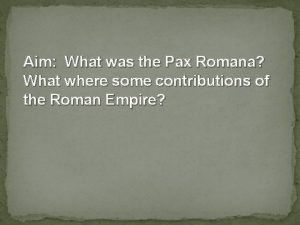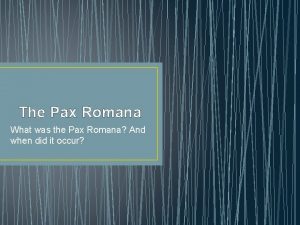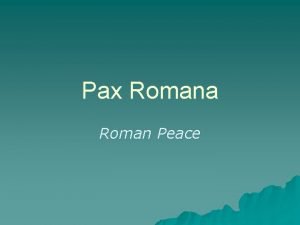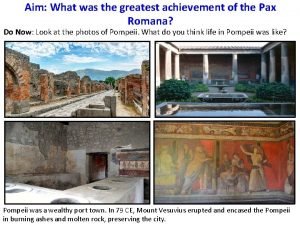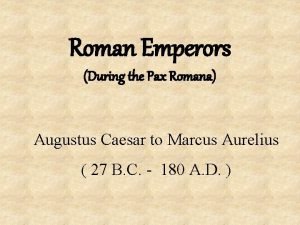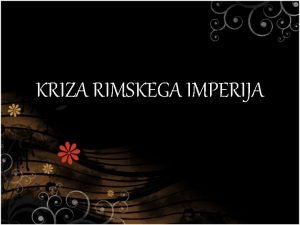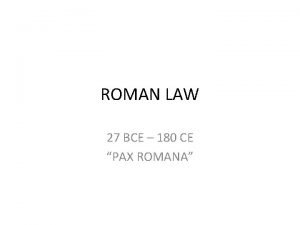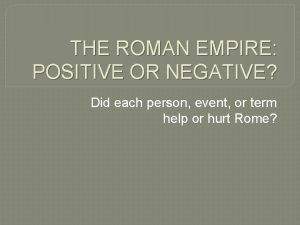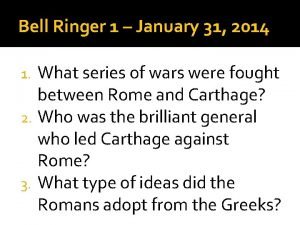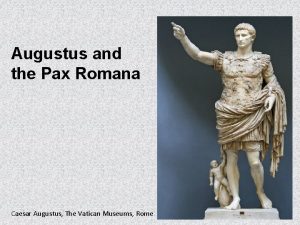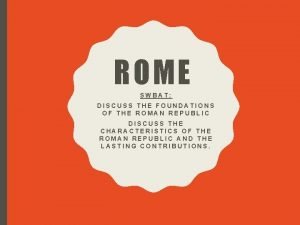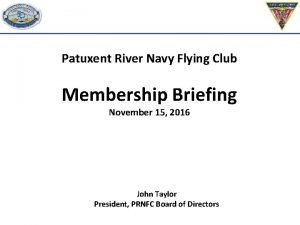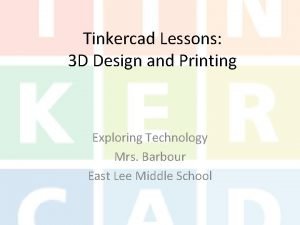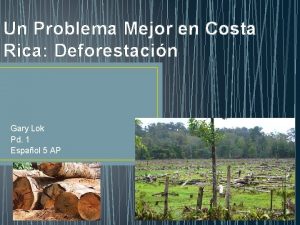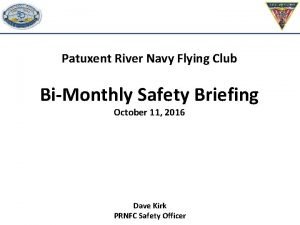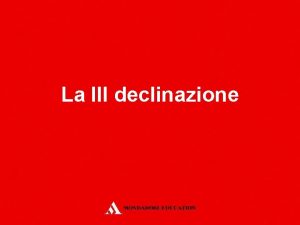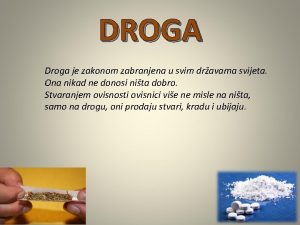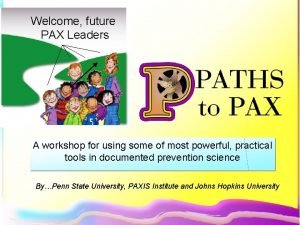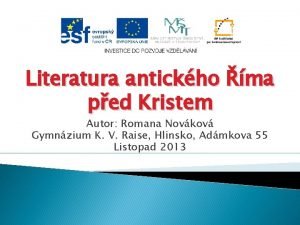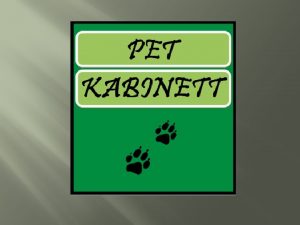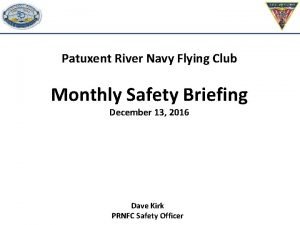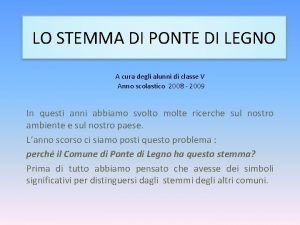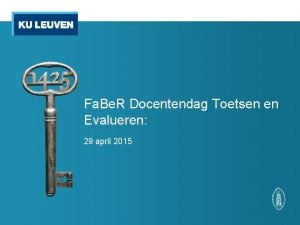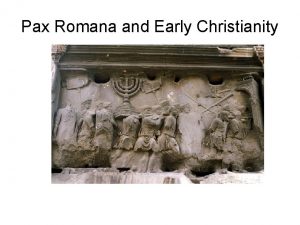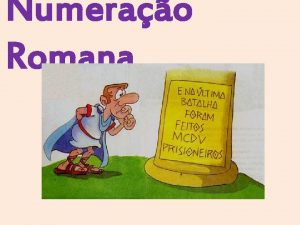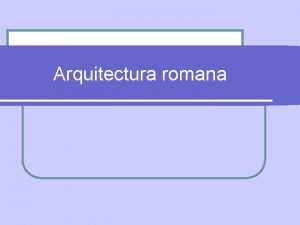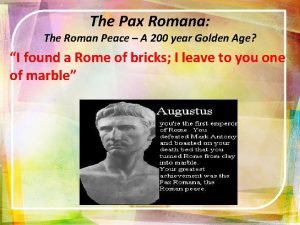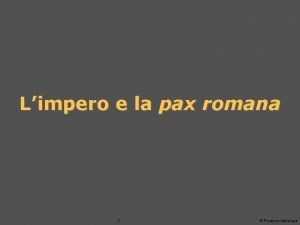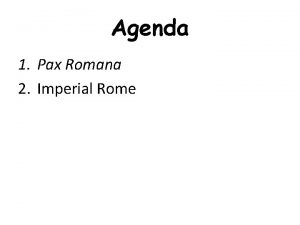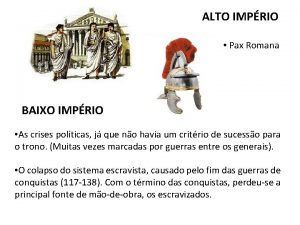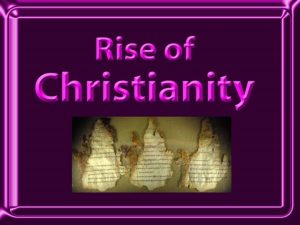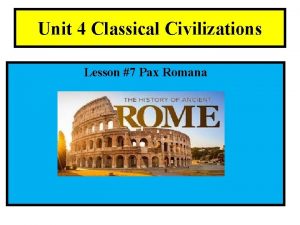Aim What was the Pax Romana What where










































- Slides: 42

Aim: What was the Pax Romana? What where some contributions of the Roman Empire?

THE PAX ROMANA: ROMAN PEACE (27 B. C. – 180 A. D. )

PAX ROMANA 200 Years of Peace and Stability in Rome

Begins with the rule of Augustus Caesar www. uoregon. edu/~arthist/arthist_204/monumentimages/primaporta_augustus. gif �Defeats forces of Marc Antony and Cleopatra �Solidifies power around 27 B. C. �Becomes “Emperor of Rome”

Pax Romana Economic Impact �Established uniform system of money - expands trade �Guaranteed safe travel and trade in empire �Army - Roman legions �Great road system - 50, 000 miles of highway �Promoted prosperity

Pax Romana Social Impact �Returned stability of social classes �Increased emphasis on family

Pax Romana Political Impact �Created Civil Service �Developed uniform rule of law � 12 Tables

Roman Law �Most lasting and widespread contribution �Laws were fair and applied equally to all people. � All persons had the right to equal treatment under the law. � Innocent until proven guilty � The burden of proof lies with the accuser, not the accused. � A person should be punished for actions, not for thoughts. � Guilt must be established “clearer than daylight” through evidence. �These laws became the basis for legal systems in Europe and Latin America

Roman public health • First to realise the connection between dirty water and poor health • Had Aqueducts and sewers • Realised that you had to build towns and settlements away from swamps and near rivers • Army had clean hospitals with good ventilation

Literature and History • The Roman Empire was unified through language. Latin was adopted by many different people and became the basis for other languages, Spanish, French, Italian, Portuguese, and English. • Poetry – Virgil wrote the Aeneid • History – Livy – wrote The History of Rome from its foundation

Philosophy �Borrowed philosophical ideas from Greeks and Hellenistic civilization �Stoicism: stresses the importance of duty, accepting one’s fate �Educated Greeks admired the Romans’ work.

Literature and History Roman poet, Virgil, writes Aenid. Hoped to arouse patriotism and unite Rome after many civil wars. Historian, Livy, wrote about Rome’s past to arouse patriotism, as well. Told stories of heroes

ROMAN ARCHITECTURE

Architecture �Romans borrowed Greek columns. �Wanted to show off their power and prestige by building immense palaces, temples, and stadiums. �First to create arches

The Pantheon �Served as a temple to the Gods �Also used for political meetings �Used domes to allow roofing over large structures.

Pantheon’s Dome

Pantheon’s Interior

Roman Bath

Roman Science A. Simplification of Greek knowledge B. Pliny the Elder (23 – 79) • Natural History • Facts, no theory • No skepticism about claims “… the place which is known by the name of Geskleithron, the Arimaspi are said to exist. . . a nation remarkable for having but one eye, and that placed in the middle of the forehead. This race is said to carry on a perpetual warfare with the Griffins, a kind of monster, with wings, as they are commonly represented, for the gold which they dig out of the mines, and which these wild beasts retain and keep watch over with a singular degree of cupidity, while the Arimaspi are equally desirous to get possession of it. ”


Arch of Constantine


Roman Entertainment

Roman Coliseum Used for: �Training slaves to fight �Gladiator contests �Battles, dramas, and

Arena is Latin for sand, coating the floor that soaks up the blood of the combatants.

Circus Maximus �Rome’s largest racecourse �Chariot racing – winners of the race were hailed heroes! �Both the Coliseum and Circus Maximus diverted the attention of the poor to the enjoyment of games, races, and battles. �Used as a way to control the mob!

Early Roman Amphitheater Seats about 20, 000

Roman Theater

Roman Roads Originally built for the Roman Army Complex roads brought the empire together. ALL ROADS LEAD TO ROME!

Roman Aqueduct �Definition: bridge-like stone channel that brought water from the hills to the city �Only the rich had water piped in. �People gathered here to wash and hear the latest news. �Availability of fresh water was important to the Romans.

Aqueduct in Segovia

Hadrian’s Wall in Britain

Roman Sculpture �Romans borrowed much of their art from the Greeks. �Their statues had expression and attitude; represented the power and leadership of Rome. �Adopted “realism” from Hellenistic civilizations �Revealed every aspect of detail (good or bad!)

The Sciences �Greco-Roman Civilization: a blend of Greek, Roman, and Hellenistic culture and traditions �A lot of the science was left to the Greeks (who were now citizens of Rome). �Alexandria, in Egypt, continued to be the center of learning. Pliny the Elder Roman scientist who compiled volumes of geography, zoology, botany, and others.

Roman Mosaics �Mosaics were pictures or designs made by setting small pieces of stone, glass, or tile onto surface.

Lasting Impressions Jefferson Memorial

Lincoln Memorial

U. S. Capitol Building

Federal Court, in NYC

Statue of Justice US Supreme Court Building

Metropolitan Museum of Art

YOUR TURN!!! � Using your notes on Roman Achievements during the Pax Romana, state the importance of that contribution by giving it a percentage out of 100. � For example, if you feel that the Twelve Tables are the most important contribution, it could make up 40% of the nutritional facts; if you feel that aqueducts did not provide enough of a contribution, you can make them worth only 5% of the nutritional value. � YOUR NUTRITION FACTS MUST EQUAL UP TO 100%. �The following six (6) categories for achievements MUST be included in the “Nutrition Facts” �Be sure to include a specific achievement for each category! 1. Architecture 2. Entertainment 3. Science 4. Art 5. Engineering 6. Literature/Philosophy/History
 Pax romana importance
Pax romana importance Pax romana political impact
Pax romana political impact Roman empire
Roman empire Pax romana achievements
Pax romana achievements Roman numeraos
Roman numeraos Pax romana
Pax romana Pax romana law
Pax romana law As a result of 207 years of pax romana, the roman empire
As a result of 207 years of pax romana, the roman empire Pax romana brainpop worksheet answers
Pax romana brainpop worksheet answers Pax romana social impact
Pax romana social impact Pax romana
Pax romana Red lion pax programming
Red lion pax programming Pax river flying club
Pax river flying club Fredsgudinna
Fredsgudinna Lms paxpat
Lms paxpat Ms bixby's last day summary
Ms bixby's last day summary Pax natura
Pax natura Pax river flying club
Pax river flying club Tema in dentale latino
Tema in dentale latino Pax colonia
Pax colonia Kokainq
Kokainq Ro i rom pax
Ro i rom pax Pax leaders
Pax leaders Pax animae
Pax animae Httpswww.youtube.comwatchvdqw4w9wgxcq
Httpswww.youtube.comwatchvdqw4w9wgxcq Pax river flying club
Pax river flying club Pax evan tibi geli mar sta ce meus traduzione
Pax evan tibi geli mar sta ce meus traduzione Hitler
Hitler Ouderportaal pax
Ouderportaal pax điện thế nghỉ
điện thế nghỉ Các loại đột biến cấu trúc nhiễm sắc thể
Các loại đột biến cấu trúc nhiễm sắc thể Biện pháp chống mỏi cơ
Biện pháp chống mỏi cơ Trời xanh đây là của chúng ta thể thơ
Trời xanh đây là của chúng ta thể thơ Gấu đi như thế nào
Gấu đi như thế nào Thiếu nhi thế giới liên hoan
Thiếu nhi thế giới liên hoan Phối cảnh
Phối cảnh Các châu lục và đại dương trên thế giới
Các châu lục và đại dương trên thế giới Một số thể thơ truyền thống
Một số thể thơ truyền thống Thế nào là hệ số cao nhất
Thế nào là hệ số cao nhất Sơ đồ cơ thể người
Sơ đồ cơ thể người Tư thế ngồi viết
Tư thế ngồi viết Bảng số nguyên tố
Bảng số nguyên tố
